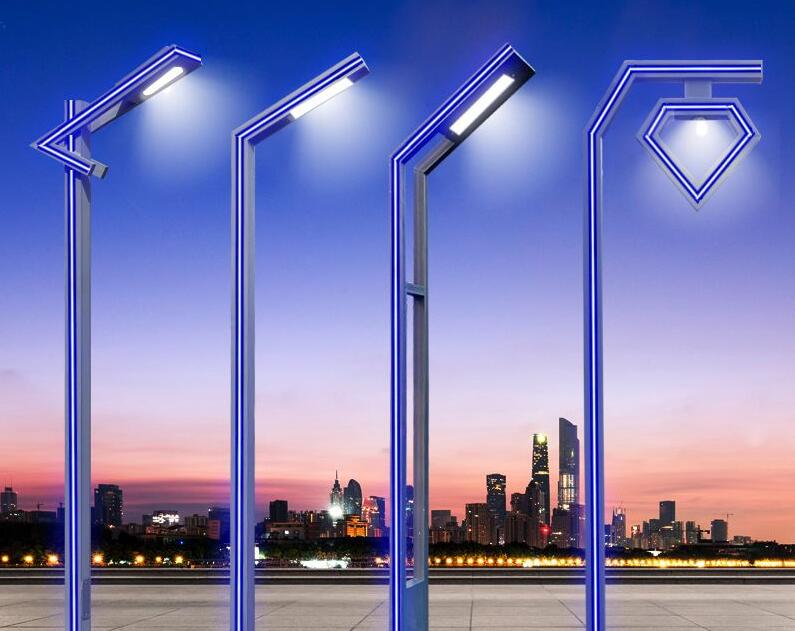Outdoor lighting engineering design, mainly for residential area roads and affiliated scenic spots, city squares, scenic spots and other site lighting design. Usually outdoor lighting can be divided into basic lighting and landscape lighting.
 1 Design Features
1 Design Features
(1) Reflect the level of civilization and add to the auspicious and peaceful atmosphere of the city. The design should start from the surrounding environment, reflect the style of the site, and reflect the image of the city. Usually outdoor lighting can be divided into basic lighting and landscape lighting.
(2) The basic lighting is generally symmetrically distributed, staggeredly distributed or evenly distributed on one side of the road, with inductive arrangement. When road lights are used, the height of the lights should not be less than 4.5m, and the arrangement distance between lights should be 25-30m. When garden lights are used, the height of the lights should not exceed 3.5m, and the arrangement distance between lights should be 15-25m. Street lighting sources usually use high-pressure sodium lamps, high-pressure mercury lamps, incandescent lamps, etc.
(3) The lighting of the scenic spot is configured according to the real scene, and the lighting is selected, and the setting of the lighting should be able to express the characteristics of the building or structure. Generally, lamps are installed on the building itself or adjacent buildings, or the two are combined, and lamps can also be placed on the ground green belt. Landscape lighting usually uses floodlights.
(4) Outdoor lighting should be remotely controlled in the duty room or substation room. The control of lighting fixtures should be considered to be able to be controlled flexibly by partition. The lamps are arranged in sequence along the road. Usually, before 24:00 at night, all lights should be on. The lighting can decide when to light up and when not to light up according to needs.
2 Design points
2.1 Power supply and distribution
(1) Outdoor lighting generally adopts low-voltage power supply. The principle of determining the power distribution cabinet needs to consider the power supply radius and the voltage drop that must be controlled from the power supply to the terminal receiving point. In GB50052- -98 “Design Code for Power Supply and Distribution System”, it is stipulated that under normal operation conditions, the allowable deviation of voltage at the end of the road lighting is +5%, -10%.
(2) The number of outlet circuits of the power distribution cabinet depends on the combination scheme of the control lighting, and those that can be switched at the same time can be powered by the same one or several circuits. The phase sequence configuration must be considered in the design, and the three-phase balance should be achieved as much as possible.
(3) The cross-section of the power supply outlet of the distribution box should generally not be greater than 35 square millimeters. For lighting power supply lines with gas discharge lamps as the main load, in a three-phase four-wire power distribution system, the cross section of the neutral wire should be selected according to the maximum current of one phase, not less than the cross section of the phase wire.
(4) The common wiring method for road lighting is to use underground direct buried cables. Directly buried distribution lines have good heat dissipation and high current-carrying capacity, and because the distributed capacitance between the cores of the cable is connected in parallel on the line, the natural power factor can be improved, and at the same time, it is not affected by the climate, reduces external damage, and improves power supply reliability.
2.2 Calculation of wire section selection
The selection of outdoor lighting cable section should be determined comprehensively by calculating the current and voltage drop indicators. The allowable carrying capacity of the wire is determined by calculating the current, and the cross-section of the wire is basically determined; the calculation of the line voltage loss can make the line have a certain margin under the premise of conforming to the plan, and the selection of the line cross-section is economical and reasonable.
(1) When selecting the wire section according to the allowable carrying capacity, the lighting load can be considered according to the long-term duty load, that is, IN=Kt*Ial>Ic. In the formula, Ial-the long-term allowable working current value of the wire, AIN-the long-term rated current of the wire after diameter correction, AIC-calculated current, AKt-correction coefficient.
(2) The load moment calculation method can be used for the voltage drop calculation, and the calculation results of each formula must be based on the most unfavorable lighting combination method as the basis for selecting the section of the power supply line.
Calculation method of voltage loss without line: (terminal load is represented by load moment Kw.Km) ①Two-wire line (single-phase, two-phase without neutral line or DC line) △U%≈6*△Up%*p*L②Three-phase Four-wire and three-phase three-wire line △U%=△Up%*P*L③Two-phase three-wire line with zero line △∪≈2.25*△Up%*P*L where △U%-voltage loss percentage value, % △Up% – The percentage of voltage loss per kilowatt and kilometer of the three-phase line, △u%kw.km P – active load, KwL- line length, Km The value of power P in the formula: ① For the basic lighting that is basically evenly distributed along the way and the landscape lighting that has a certain distance between the load and the load, but the power value is relatively uniform, it can be approximated by three-phase balance Even load calculation. If the load in ②landscape lighting is particularly concentrated, it can be calculated approximately as a three-phase balanced line. If ③in landscape lighting, the load has a certain distance, and the power changes are large and uneven, the load moment can be used to calculate section by section.
3 Lighting line protection measures
(1) Outdoor lighting generally adopts TN-S system, and a special protection line PE is set between the power point and the street lamp. Lead the 5-core cable from the power box, repeat the grounding of the PE line at the lighting distribution box, the grounding resistance R≤10 ohms, and connect the PE line to each group of street light poles along the line, and each group of light poles must also be protected against lightning Grounding, grounding resistance R ≤ 30 ohms.
(2) The “Code for Design of Low-Voltage Power Distribution” GB50054- -95 generally requires short-circuit protection and overload protection for distribution lines. The outdoor lighting circuit does not require overload protection, and the protection focuses on short circuit and ground fault protection. ① There is a circuit breaker or fuse installed in the street light pole, and it is connected with a special PE line to protect the short circuit and bump in the pole. The circuit breaker in the power distribution cabinet is correctly calculated and selected, and it can protect the short circuit of the power supply in the pole and the touch pole. ② Ground fault protection, through the correct selection and setting of line protection appliances, the time to cut off the fault can be shortened; the expected contact voltage can be reduced by the equipotential bonding of the grounding and the conductive part of the external circuit of the adjacent equipment. ③When the distance of the outdoor lighting power supply line is long, the short-circuit current at the farthest point must be checked.
4 Outdoor lighting control system
For road lighting control, the traditional control method adopts photoelectric control and quartz clock time switch control. The new control relay can not only control the street lamp circuit through the contactor according to the photoelectric signal, but also control the output circuit separately according to its internal clock and four timers, and the operation mode is flexible. If conditions are sufficient, a computer network composed of a microprocessor and a transmission bus can be used for control. A programmable controller with microprocessor is installed in each power distribution cabinet, which is connected with the central computer room by bus. The microprocessor controls the arrangement and combination control programming of each power supply circuit, and the central computer room can have any modification priority for the programmable controller in each power distribution cabinet. In this way, two control combinations of central and on-site are realized.
To sum up, outdoor lighting is a systematic project, which reflects the perfect combination of lighting technology and culture and art, and involves a wide range of contents. The design should strictly follow the design specifications formulated by the state, and take into account the specific situation and saving investment to make the most reasonable design plan.



 1 Design Features
1 Design Features